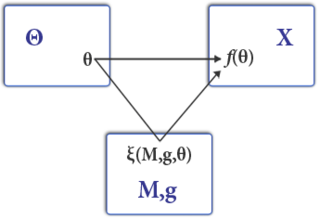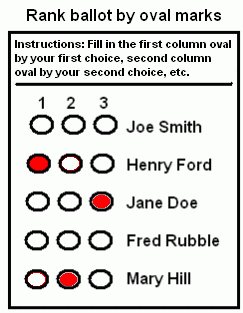
Approval voting is an electoral system in which voters can select any number of candidates instead of selecting only one.
Game theory is the study of mathematical models of strategic interactions among rational agents. It has applications in many fields of social science, used extensively in economics as well as in logic, systems science and computer science. Initially game theory addressed two-person zero-sum games, in which a participant's gains or losses are exactly balanced by the losses and gains of the other participant. In the 1950’s it was extended to the study of non zero-sum games and was eventually game applied to a wide range of behavioral relations, and is now an umbrella term for the science of rational decision making in humans, animals, as well as computers.
Strategic or tactical voting is voting in consideration of possible ballots cast by other voters in order to maximize one's satisfaction with the election's results. For example, in plurality or instant-runoff, a voter may recognize their favorite candidate is unlikely to win and so instead support a candidate they think is more likely to win.
In social choice theory, a Condorcet paradox is a situation where majority rule behaves in a way that is self-contradictory. In such a situation, every possible choice is rejected by the electorate in favor of another, because there is always some other outcome that a majority of voters consider to be better.
Arrow's impossibility theorem is a key result in social choice showing that no order or rank-based social welfare function can produce a rational measure of society's well-being when there are more than two options. Specifically, any such rule violates independence of irrelevant alternatives: the principle that a choice between and should not depend on a third, unrelated option . Such a social welfare function can be any way for a group to make decisions, such as a market or a voting system.
The Gibbard–Satterthwaite theorem is a theorem in voting theory. It was first conjectured by the philosopher Michael Dummett and the mathematician Robin Farquharson in 1961 and then proved independently by the philosopher Allan Gibbard in 1973 and economist Mark Satterthwaite in 1975. It deals with deterministic ordinal electoral systems that choose a single winner, and shows that for every voting rule of this form, at least one of the following three things must hold:
- The rule is dictatorial, i.e. there exists a distinguished voter who can choose the winner; or
- The rule limits the possible outcomes to two alternatives only; or
- The rule is not straightforward, i.e. there is no single always-best strategy.

Mechanism design is a branch of economics, social choice theory, and game theory that deals with designing games to implement a given social choice function. Because it starts at the end of the game and then works backwards to find a game that implements it, it is sometimes called reverse game theory.
In political science and social choice theory, the median voter theorem states that if voters and candidates are distributed along a one-dimensional spectrum and voters have single peaked preferences, any voting method satisfying the Condorcet criterion will elect the candidate preferred by the median voter.
Social choice theory or social choice is a branch of welfare economics that analyzes mechanisms and procedures for collective decision-making. Social choice incorporates insights from economics, mathematics, and game theory to find the best ways to combine individual opinions, preferences, or beliefs into a single coherent measure of the quality of different outcomes, called a social welfare function.
Allan Fletcher Gibbard is the Richard B. Brandt Distinguished University Professor of Philosophy Emeritus at the University of Michigan, Ann Arbor. Gibbard has made major contributions to contemporary ethical theory, in particular metaethics, where he has developed a contemporary version of non-cognitivism. He has also published articles in the philosophy of language, metaphysics, and social choice theory: in social choice, he first proved the result known today as Gibbard-Satterthwaite theorem, which had been previously conjectured by Michael Dummett and Robin Farquharson.
The Duggan–Schwartz theorem is a result about voting systems designed to choose a nonempty set of winners from the preferences of certain individuals, where each individual ranks all candidates in order of preference. It states that for three or more candidates, at least one of the following must hold:
- The system is not anonymous.
- The system is imposed.
- Every voter's top preference is in the set of winners.
- The system can be manipulated by either an optimistic voter, one who can cast a ballot that would elect some candidate to a higher rank than all of those candidates who would have been elected if that voter had voted honestly; or by a pessimistic voter, one who can cast a ballot that would exclude some candidate to a lower rank than all of those candidates who were elected due that voter voting strategically.
The revelation principle is a fundamental result in mechanism design, social choice theory, and game theory which shows it is always possible to design a strategy-resistant implementation of a social decision-making mechanism. It can be seen as a kind of mirror image to Gibbard's theorem. The revelation principle says that if a social choice function can be implemented using some non-truthful mechanism, the same function can be implemented by a truthful mechanism which has the same equilibrium outcome (payoffs).

Artyom Shneyerov is a microeconomist working at Concordia University in Montreal, Quebec, Canada. He is also an associate editor of the International Journal of Industrial Organization. His current research is in the fields of game theory, industrial organization and applied econometrics. His contributions to these and other areas of economics include the following:

Reginald Robin Farquharson was an academic whose interest in mathematics and politics led him to work on game theory and social choice theory. He wrote an influential analysis of voting systems in his doctoral thesis, later published as Theory of Voting, and conjectured the Gibbard–Satterthwaite theorem together with the philosopher and logician Michael Dummett.

Ehud Kalai is a prominent Israeli American game theorist and mathematical economist known for his contributions to the field of game theory and its interface with economics, social choice, computer science and operations research. He was the James J. O’Connor Distinguished Professor of Decision and Game Sciences at Northwestern University, 1975–2017, and currently is a Professor Emeritus of Managerial Economics and Decision Sciences.

Rated voting refers to any electoral system which allows the voter to give each candidate an independent evaluation, typically a rating or grade. These are also referred to as cardinal, evaluative, or graded voting systems. Cardinal methods and ordinal methods are the two modern categories of voting systems.

The term ranked voting, also known as preferential voting or ranked-choice voting, pertains to any voting system where voters indicate a rank to order candidates or options—in a sequence from first, second, third, and onwards—on their ballots. Ranked voting systems vary based on the ballot marking process, how preferences are tabulated and counted, the number of seats available for election, and whether voters are allowed to rank candidates equally.

Arunava Sen is a professor of economics at the Indian Statistical Institute. He works on Game Theory, Social Choice Theory, Mechanism Design, Voting and Auctions.
Maximal lotteries are a tournament voting rule that elects the majority-preferred candidate if one exists, and otherwise elects a candidate from the majority-preferred set by a randomized voting procedure. The method selects the probability distribution of candidates that a majority of voters would prefer to any other.
In the fields of mechanism design and social choice theory, Gibbard's theorem is a result proven by philosopher Allan Gibbard in 1973. It states that for any deterministic process of collective decision, at least one of the following three properties must hold:
- The process is dictatorial, i.e. there is a single voter whose vote chooses the outcome.
- The process limits the possible outcomes to two options only.
- The process is not straightforward; the optimal ballot for a voter depends on their beliefs about other voters' ballots.








